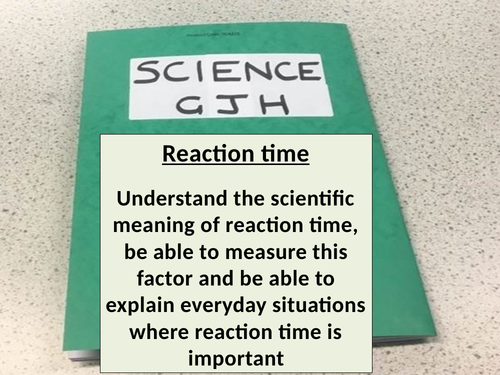


This is a detailed lesson which looks at the topic of reaction times and guides students through calculating a reaction time using the results of the well known ruler-drop test. In addition, students will see how reaction times can be applied in athletics but also in the calculation of the thinking distance for drivers. The lesson includes an engaging lesson presentation (32 slides) and a student task worksheet.
The lesson begins by introducing the key term, reaction time, and teaching students that the average reaction time is 0.2 seconds. Moving forwards, a step by step guide is used to show the students how to take the value for distance travelled by a ruler in the drop test and use the equations of motion and change in velocity equation to calculate the reaction time. There is a large mathematical element to the lesson which challenges the students ability to rearrange formula, convert between units and leave answers to a specified number of significant figures. The answers and methods in obtaining these are always displayed at the end of each task so that the students can assess their understanding and recognise where errors were made if any were. Students will have to follow the provided method to obtain 5 results in the ruler drop test and ultimately find out their own reaction time. The remainder of the lesson looks at how the thinking distance at different speeds can be calculated.
This lesson has been written for GCSE students due to the high maths content but could be used with younger students of high ability.
Get this resource as part of a bundle and save up to 36%
A bundle is a package of resources grouped together to teach a particular topic, or a series of lessons, in one place.
Topic P6.1: Physics on the move (OCR Gateway A GCSE Combined Science)
This bundle of 3 lessons covers most of the content in sub-topic P6.1(Physics on the move) of the OCR Gateway A GCSE Combined Science specification. The topics or specification points covered within these lessons include: Everyday motion Reaction time and thinking distance Stopping distances All of these lesson presentations and accompanying resources are detailed and engaging and contain regular progress checks to allow the students to constantly assess their understanding.
Topic P8: Global challenges (OCR Gateway A GCSE Physics)
This bundle of 9 lessons covers a lot of the content in Topic P8 (Global challenges) of the OCR Gateway A GCSE Physics specification. The topics and specification points covered within these lessons include: Everyday motion Reaction time and thinking distance Braking distance and stopping distance Energy sources Using resources The National Grid Mains electricity The Big Bang Satellites and orbits All of these lesson presentations and accompanying resources are detailed and engaging and contain regular progress checks to allow the students to constantly assess their understanding.
Topic P6: Global challenges (OCR Gateway A GCSE Combined Science)
This bundle of 6 lessons covers the majority of the content in Topic P6 (Global challenges) of the OCR Gateway A GCSE Combined Science specification. The topics and specification points covered within these lessons include: Everyday motion Explain methods of measuring human reaction times and recall typical results Explain the factors which affect stopping distance The main energy sources available on Earth The differences between renewable and non-renewable energy sources The use of transformers to increase and decrease potential difference The National grid and mains electricity The differences in function of the wires in a three core cable All of these lesson presentations and accompanying resources are detailed and engaging and contain regular progress checks to allow the students to constantly assess their understanding.
Topic P5: Forces (AQA Trilogy GCSE Combined Science)
This bundle of 14 lessons covers the majority of the content in Topic P5 (Forces) of the AQA Trilogy GCSE Combined Science specification. The topics covered within these lessons include: Contact and non-contact forces Weight, mass and gravity Resultant forces Work done Investigating springs Speed and velocity Acceleration Distance and velocity-time graphs Terminal velocity Stopping distances Reaction times Momentum All of these lesson presentations and accompanying resources are detailed and engaging and contain regular progress checks to allow the students to constantly assess their understanding.
Something went wrong, please try again later.
This resource hasn't been reviewed yet
To ensure quality for our reviews, only customers who have purchased this resource can review it
Report this resourceto let us know if it violates our terms and conditions.
Our customer service team will review your report and will be in touch.